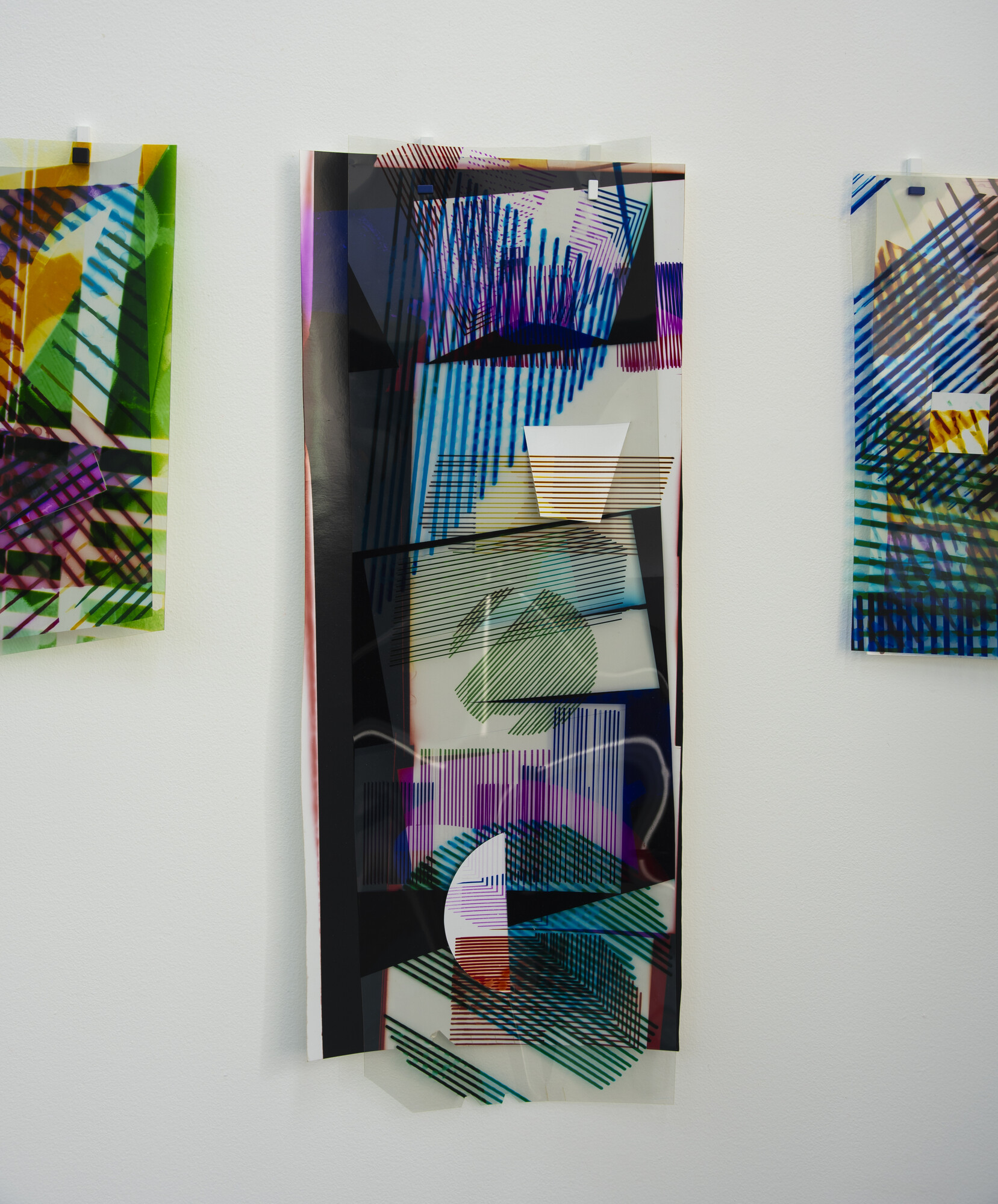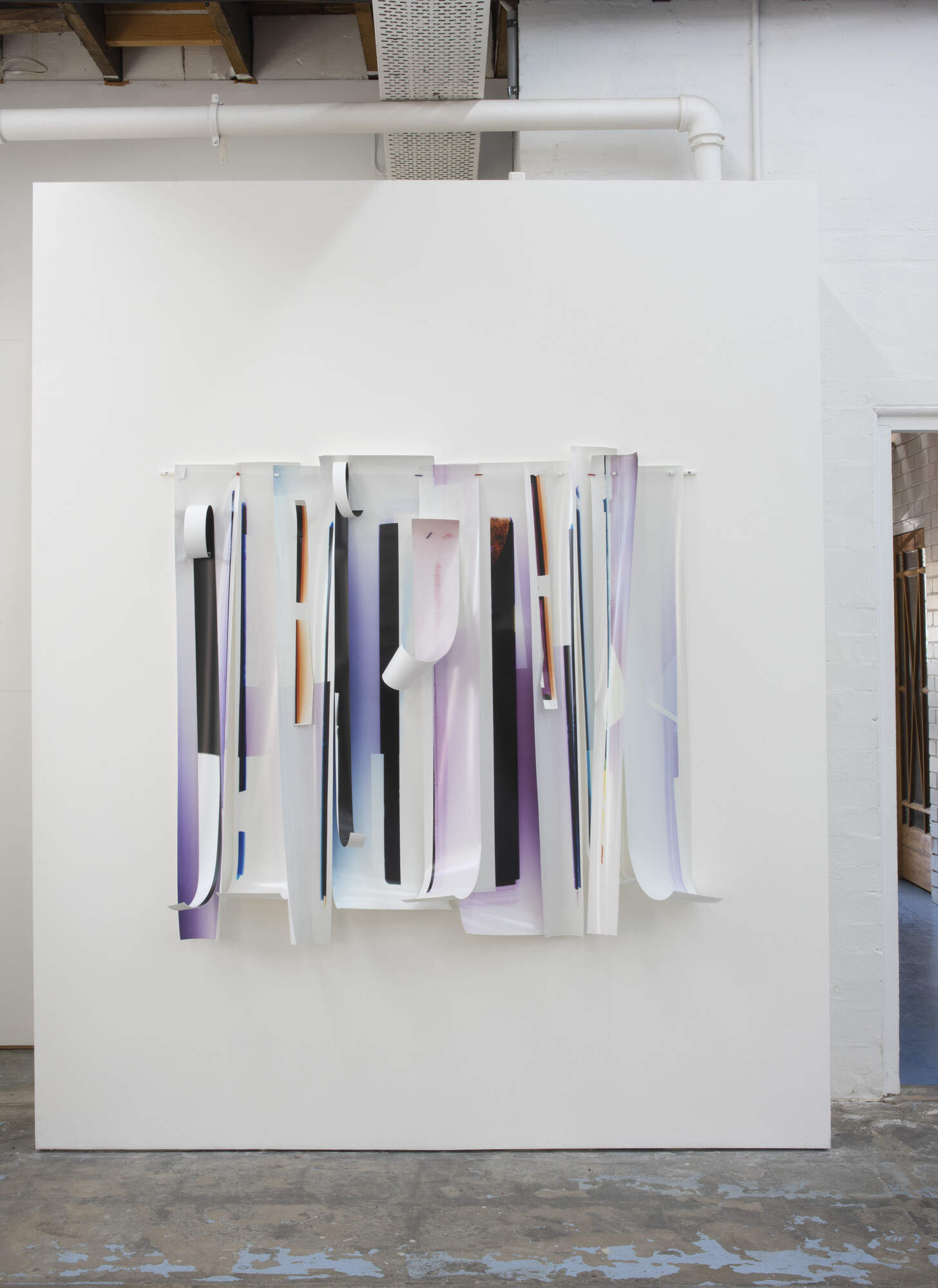Colour Bleeds and Light Folds
Loqui Paatsch
There are some that are in darkness, and others that are in light. On the reverse of Danica Chappell’s Far From The Eye (Fingertip Glance #4), there’s a secret, if you’re bold enough to circle around the hanging print and peek: more exquisite, stained-glass geometry lies there. Hovering prettily in space, the print stretches down from the ceiling, hanging almost to the floor; blocks of intense, heavily layered colour stack atop each other, centred on the glossy paper. Inside this serene white warehouse space, six works wrap around the walls, deep coloured and patchworked with motley variations.
Here, in her show Colour Bleeds and Light Folds, currently on display at Mejia, Chappell presents a series of photographic prints and experiments, spanning almost ten years of her practice. Cameras, notes curator Sue Cramer, are of no interest to Chappell. She works intuitively in her colour darkroom, operating in the absence of light only by touch. C-type paper is so sensitised that even a red light creates marred, foggy traces. Layering translucent coloured gels and paper shapes, Chappell creates superimposed, complex arrangements in glowing jewel tones, relying on her peculiar haptic intuition. Photograms rely on blocking and selectively withholding light, deciding what to reveal or shield, with this instinctive experimentation bypassing pedantry and exactitude. There’s a tendency to mystify the alchemy of the darkroom, and indeed optics itself: from wise lens grinders dying from silicosis to the withdrawn shutterbug, shrinking from the sun. Chappell draws back the curtain, opens the darkroom door, and exposes her process to a different sort of light.
Across an entire wall, a grid of layered stacks of paper marches on, affixed with tiny magnets, cutely shaped like Xs, Os, petite squares and rectangles that almost blend in to the mix—blink, and you’ll miss them. Colour Bleed and Light Folds (test strips 2013–2023) is, naturally, an assembly of ten years of test strips, marking time and effort like punch cards, clocked in to the business of making images. Grouped in trios, this grid is a beautiful structure for perception, for legibility. The strips themselves are uneven, cut straight but not uniform, overlapping each other like feathers. The devil is, as always, in the details—stray hairs or motes of dust make almost imperceptible shivering traces, undercutting the linear order and rhythm. She incorporates silver gelatin prints here too, some peeking out from underneath slivers of gaudy magenta and marigold.
It’s bewildering to see the work recur and elaborate upon itself: yellow and black meshed grids, polka dots and cropped circles, an indexical sampler. Despite this extension of her studio space into the gallery and the playfulness of her operation, there’s no messy DIY quality at work here—the formal, quiet logic of these images wouldn’t allow for it.

The variegation and use of striated lines isn’t merely a cute visual trick, or suprematist visual device for organising the image, but a trace of the work’s production, making the frustrating, boring, horribly necessary process of developing test strips an end in itself. Seconds into stripes. The darkroom necessitates compulsive repetition, and a particular form of patience that always eluded me. It demands that you collude with time, and yet attempt to manipulate it into delivering some ideal result, formulated in your mind’s eye. Not seeking to arrest time, to halt its motion or capture it, fixed to a plate or anchored to some emotive fragment, Chappell’s cleverness is in embracing this slippage. Her vision is located in her hands. And it’s hands, or more exactly, handling that thrills me as I look through the accompanying catalogue (gloves on, natch). Concertinaed in heavy card, small prints reveal themselves and fall back in sequence.
Photography has become a hands-off process, superbly automated and mechanised. Despite the tricks and advances in gimmickry, this is still a business of feeling, of feeling one’s way through paper, through gaps, and into moments, with Chappell manoeuvring deftly through photographic history and techniques—every triangle a little shadow of the first photograph, Niepce’s famous rooftops.
The final product of these photogram fragments lies behind glass, yet another layer, another filter. Blue Works (Light-Modulated Form #1–#4) are a sweet duo, not exactly identical twins, but at least siblings. There’s a softness to these, a fading around the edges that makes their depth shaky, a heavy weight brought to bear inside indifferent white frames. I last encountered Chappell’s work at Melbourne Now: a series of large, frenetically patterned and angular prints draped charmingly on thin white supports, much like clothing racks. In that atrium, backlit slightly by a window, her installation appeared to me as a still point in the turning, frustrating world of that show, perhaps because of its determined lack of fussiness—content to be arrested and fixed by light.

The great trick that photography has always played on me is that of equivalence, an insistent reminder of another moment not quite like this one, but similar enough. Earlier this week, I couldn’t see a photo of a camera-wielding, freshly buzzed Kim Kardashian without instantly thinking of combat photo-journalist Marie-Laure de Decker’s intense seventies self-portraits, confrontational, and stylised. Similarly, among these glowing rectangles and gel transparencies, I can’t help but reflect on Leonard French’s playful abstracts and glass works, especially here in Brunswick on his home turf. Equally, it’s impossible to escape the echoes of the Bauhaus and early modernism in Chappell’s photography. In her exhibition text, Cramer references Lazlo Moholy-Nagy’s 1922 Light Prop for an Electric Stage (Light Stage Modulator), drawing a comparison between their respective uses of perforation and circular motifs. In Chappell’s instance, it’s photographic shorthand, gesturing towards the aperture, the gap through which all becomes visible, a strategy for locating the work at the threshold of its indexation. While Moholy-Nagy brought these forms into relation in space, Chappell flattens them into component parts, cautiously demonstrating their construction before arriving at the final print.

Form follows function; the ur-modernist diktat, holds true here—the paper ventriloquises and dictates, the dials turn, minute adjustments are made to the machine, but no matter what duress the material is under, it retains its agency. Colour Fall (from the series Haptic Eye, 2022), a grouping of twelve black and white framed prints, echoes the graffitied windows on either side, the surface of the prints themselves embellished (or defaced) with the addition of blocky hand-coloured shapes. It’s a struggle for me to suppress some nasty pareidolic urge to see figuration or something literal here, to read them as a still life or documentation of some three-dimensional arrangement rather than the product of density and interventions.
Another grouping of test strips brings to mind mayday calls, nautical flag signals made by the soft fuzzy contours of a piece moved by the brush of a hand in the dark. These are not opaque, but instead permeable and translucent. Built up from Duratran, with some cut and incised to allow others to puncture through, they’re hung lower and lie flatter than their curled paper counterparts. It’s a further explication of process, to be sure—again eliding the camera—directing the eye to solidly fill itself in and take on the work of the apparatus with an unremitting optical glare, oscillating inside itself. The frantic depth of these is even more apparent in comparison to Colour Bleeds (paper trims, 2022), a soft vertical tapestry of offcuts in blushing lilacs and pinks, shyly joyous and perfect for early spring. Segments unfurl from each other, blossoming out. There’s a true generosity of spirit, or even openness, in Chappell’s practice, but while we’re invited in, we may only see that which is illuminated; everything in darkness drops from sight.
Loqui Paatsch is a writer and arts worker from Melbourne/Narrm.